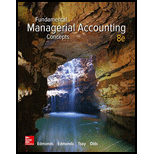
a.
The product that should be sold or produced if the demand is higher than the company’s capacity.
a.
Explanation of Solution
Scarce resource utilization: It is a decision is a result with respect to the superlative utilization of scarce resources in order to boost the net income of a business. Scarcity of various resources positions imperatives on the measure of item that can be created utilizing those resources.
Outsourcing: It can be termed as conveying all or part of an activity to a supplier or a provider. While outsourcing was initially limited to fundamental activities, it as of now invades the administration of numerous organizations.
Opportunity cost: Opportunity cost is the forfeit of certain benefits such as cost savings, incomes, which is surrendered by not picking an option. Opportunity costs are applicable in decisions where the acknowledgment of one option disqualifies the likelihood of selecting different alternatives.
The product that should be produced or sold if the demand is higher than the company’s capacity is as follows:
While Product B manufactures a greater contribution of margin per unit, the thought should likewise be given to the labor that it takes to create each item. This can be practiced by estimating the contribution of margin per labor hour.
Determine the contribution per margin for each product
Therefore the contribution per margin for Product A is $16 and Product B is $20.
Determine the contribution margin per labor hour for each product
Therefore the contribution margin per labor hour for Product A is $8 and Product B is $5.
From the results obtained above, according to the contribution margin per labor hour, Product A should be produced.
Therefore Product A should be produced.
b.
The product that should be sold or produced for the public in retail stores.
b.
Explanation of Solution
The product that should be sold or produced for the public in retail stores is as follows:
Since the company can stock one item as a result of limited floor space, the item that provides the higher total contribution margin should be selected. Unmistakably, Product B has the greater contribution margin per unit. However the company can sell additional units of Product A.
Determine the total contribution margin for each product
Therefore the total contribution margin for Product A is $128,000 and Product B is $180,000.
From the results obtained, Product B has the greater contribution margin per unit and the greater total contribution margin. Hence, Product B should be sold.
Therefore Product B should be sold.
c.
The product that should be produced or sold if the company can sell all the products it produces.
c.
Explanation of Solution
The product that should be produced or sold if the company can sell all the products it produces is as follows:
While Product B has the greater contribution margin per unit, the thought must be provided to the machine hours necessary to create the items. This can be achieved by figuring the contribution margin per machine hour. Product A should be created according to the contribution margin per machine hour. Provided that the company has a highest capacity of 40,000 machine hours and can trade every one of the items it manufactures, Product A will expand the profits by $256,000 where Product B can just build the profits by $200,000.
Determine the total contribution margin per machine per hour for each product
Therefore the total contribution margin per machine per hour for Product A is $6.40 and Product B is $5.
Determine the increase in profit for each product
Therefore the increase in profit for Product A is $256,000 and Product B is $200,000.
From the results obtained, Product B makes higher profit per unit, yet the productivity relies upon the quantity of machine hours associated with creating the item. Product A manufactures a higher profit for each machine hour since it takes less machine hours to manufacture. Hence Product A should be produced.
Therefore Product A should be produced.
Want to see more full solutions like this?
Chapter 6 Solutions
Fundamental Managerial Accounting Concepts
- Don't use ai given answer general accountingarrow_forwardArdor Ltd. purchased a new equipment that is expected to be used in operations for 6 years for $60,000. The salvage value of the equipment after 6 years is $6,000. Assume the equipment was purchased on the first day of the fiscal year so no partial-year depreciation is needed. Using the Straight-Line Depreciation Method, what is the value of accumulated depreciation at the end of year 4?arrow_forwardGeneral Accountingarrow_forward
- Accountingarrow_forwardI am trying to find the accurate solution to this financial accounting problem with the correct explanation.arrow_forwardKD Industries has 30 million shares outstanding with a market price of $20 per share and no debt. KD has had consistently stable earnings and pays a 35% tax rate. Management plans to borrow $200 million on a permanent basis through a leveraged recapitalization in which they would use the borrowed funds to repurchase outstanding shares. The present value of KD's interest tax shield is closest to a. $130 million b. $200 million c. $400 million d. $70 millionarrow_forward

 AccountingAccountingISBN:9781337272094Author:WARREN, Carl S., Reeve, James M., Duchac, Jonathan E.Publisher:Cengage Learning,
AccountingAccountingISBN:9781337272094Author:WARREN, Carl S., Reeve, James M., Duchac, Jonathan E.Publisher:Cengage Learning, Accounting Information SystemsAccountingISBN:9781337619202Author:Hall, James A.Publisher:Cengage Learning,
Accounting Information SystemsAccountingISBN:9781337619202Author:Hall, James A.Publisher:Cengage Learning, Horngren's Cost Accounting: A Managerial Emphasis...AccountingISBN:9780134475585Author:Srikant M. Datar, Madhav V. RajanPublisher:PEARSON
Horngren's Cost Accounting: A Managerial Emphasis...AccountingISBN:9780134475585Author:Srikant M. Datar, Madhav V. RajanPublisher:PEARSON Intermediate AccountingAccountingISBN:9781259722660Author:J. David Spiceland, Mark W. Nelson, Wayne M ThomasPublisher:McGraw-Hill Education
Intermediate AccountingAccountingISBN:9781259722660Author:J. David Spiceland, Mark W. Nelson, Wayne M ThomasPublisher:McGraw-Hill Education Financial and Managerial AccountingAccountingISBN:9781259726705Author:John J Wild, Ken W. Shaw, Barbara Chiappetta Fundamental Accounting PrinciplesPublisher:McGraw-Hill Education
Financial and Managerial AccountingAccountingISBN:9781259726705Author:John J Wild, Ken W. Shaw, Barbara Chiappetta Fundamental Accounting PrinciplesPublisher:McGraw-Hill Education





